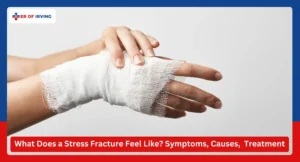How to Tell If a Bone Is Fractured or Bruised: Key Signs
Bone injuries, like fractures or bruises, can cause significant pain and confusion. If you’ve taken a fall, been in a sports accident, or experienced trauma, you might wonder, “Is my bone fractured or just bruised?” Knowing the difference is crucial for getting the right care.
At ER of Irving, a 24/7 emergency room in Irving, TX, we use Diagnostic Imaging Services to evaluate bone pain and rule out serious injuries. This guide covers the key signs of a fractured or bruised bone, including stress fractures and bruised sternum symptoms, to help you decide when to seek medical attention.
Understanding Bone Injuries: Fractures and Bruises
In some cases, what feels like a bone injury might be related to soft tissue or cartilage issues, such as Slipping Rib Syndrome. This condition often mimics rib fractures or sternum bruises, causing sharp chest or upper abdominal pain. Bone injuries can be confusing because their symptoms overlap. Here’s a detailed breakdown of each:
What Is a Bone Fracture?
A bone fracture occurs when a bone breaks or cracks due to force, stress, or underlying conditions. Fractures range from minor to severe, affecting bones like the femur, wrist, or foot. Common types include:
- Stress fracture: Hairline cracks from repetitive stress, like running long distances, often start as a dull ache that worsens to sharp pain with activity.
- Simple fracture: A clean break where bone ends stay aligned, common in falls.
- Compound fracture: A severe break where the bone pierces the skin, risking infection.
- Greenstick fracture: A partial break where the bone bends, typical in children due to flexible bones.
- Comminuted fracture: The bone shatters into multiple pieces, often from high-impact trauma.
Fractures cause intense pain and may alter the bone’s shape, making movement difficult. For example, a fractured foot might prevent walking.
What Is a Bone Bruise?
A bone bruise, or contusion, results from trauma that causes bleeding under the bone’s surface without breaking it. These micro-fractures are less severe but can mimic fractures. Types include:
- Subperiosteal hematoma: Bleeding under the bone’s outer layer, often in the shins.
- Interosseous bruise: Damage to the bone marrow, common in the knees or feet.
- Subchondral bruise: Bleeding between cartilage and bone, seen in joints.
Bone bruises occur in sports collisions, minor falls, or car accidents.
Symptoms: How to Tell the Difference

How to tell if a bone is broken or just bruised? Or how to tell if a bone is fractured or sprained? Symptoms vary by injury, and understanding them is key. Below is a detailed comparison, including foot-specific injuries :
Table: Fracture vs. Bruised Bone vs. Sprain Symptoms
| Symptom | Fracture | Bone Bruise |
| Pain | Sharp, searing, immediate, worsens with movement or weight-bearing | Deep, throbbing ache; intensifies with pressure |
| Swelling | Rapid, severe, around the bone | Gradual, moderate, diffuse |
| Deformity | Visible | None |
| Mobility | Severely limited or impossible | Reduced, with stiffness |
| Sound/Sensation | Snap, crack, or grinding at the injury | Tenderness, no distinct sound |
| Bruising | May occur, less prominent | Prominent, blue-black discoloration |
Detailed Symptom Breakdown
Bone Bruise Symptoms:
If you’re wondering what a bruised bone feels like, it’s typically a deep, internal ache that intensifies with pressure or movement. Common symptoms include swelling, warmth, and visible discoloration like blue or purple hues.
Fracture Symptoms:
Fracture pain is intense and sharp, especially with movement, and doesn’t ease at rest. Swelling and bruising occur around the bone, and the affected area may appear deformed or misaligned. The bone may be immobile, making it difficult or impossible to move or bear weight, like a fractured leg that prevents walking.
Tip: If pain radiates to the back, it could resemble back pain, signaling a need for medical evaluation.
What Causes Bone Injuries?
Each injury has distinct causes, often tied to trauma or stress:
Fractures:
Fractures can result from high-impact trauma like falls, car accidents, or workplace injuries. In athletes, repetitive stress from activities like running or dancing may cause stress fractures over time. Weakened bones due to osteoporosis in older adults or growth-related conditions in children also increase the risk of fractures.
Bone Bruises:
Bone bruises commonly occur due to direct impacts or trauma. In sports, collisions or blunt force, like a kick to the shin or a fall, can bruise bones. A typical example is a bruised sternum from seatbelt pressure during a car accident. Foot bones may also bruise from stepping awkwardly on uneven surfaces or dropping heavy objects.
Who Is at Risk for Bone Injuries?
Certain groups are more prone to bone injuries due to age, activity, or health. Athletes face high risks from impact or overuse, often leading to fractures or sprains. Children, with softer bones, are vulnerable to breaks and bruises from falls during play.
Older adults are more likely to suffer fractures from minor accidents due to osteoporosis. Manual workers risk injuries like foot fractures from dropped equipment. Those with joint conditions or past sprains are more susceptible to recurring sprains.
How Are Bone Injuries Diagnosed?

Accurate diagnosis is critical to distinguish fractures, bruises, and sprains. Healthcare providers use:
Physical Exam
- Assessing pain, swelling, and deformity. For a bruised sternum, providers check breathing patterns to rule out cardiac & chest pain.
- Testing mobility: Fractures limit movement; sprains cause joint looseness.
- Palpation: Pressing the foot can reveal bruise tenderness vs. fracture pain.
Imaging
- X-rays: The gold standard for fractures, showing breaks or cracks within seconds. Essential for how to tell whether a bone is fractured or sprained.
- CT Scans: Detailed views for complex fractures or stress fractures.
Treatment Options and Recovery
Treatment varies by injury, focusing on stabilization and pain relief:
Fracture Treatment:
- Stabilization: Splints, braces, or casts immobilize the bone. For foot fracture treatment, a boot may be used.
- Pain management: Medications reduce discomfort and are administered carefully.
- Specialist referral: Orthopedists handle casting or surgery.
- Recovery: 6–12 weeks, depending on severity. Stress fractures may heal faster with rest.
Bone Bruises Treatment:
- RICE method: Rest, ice, compression, elevation to heal a bone bruise fast. Ice reduces swelling within 48 hours; compression supports the area.
- Pain relief: Over-the-counter options or prescribed medications.
- Activity modification: Avoid impact during bone bruise recovery time (2–8 weeks). For a bruised sternum, limit coughing or heavy lifting.
- Recovery stages: Initial swelling (1–2 weeks), pain reduction (3–6 weeks), full healing (6–8 weeks).
How to Heal a Bone Bruise Fast

To heal a bone bruise fast, follow these detailed steps:
- Rest: Avoid weight-bearing activities. Use crutches for foot bruises.
- Ice: Apply ice for 15–20 minutes every 2–3 hours in the first 48 hours.
- Compression: Wrap with an elastic bandage, but not too tightly.
- Elevation: Keep the injured area above heart level to reduce swelling.
- Avoid aggravation: Skip sports and heavy lifting during recovery (2–8 weeks).
When to Seek Medical Attention
Bone injuries don’t always require immediate care, but certain symptoms demand attention:
- Severe pain or inability to move, indicating a possible fracture.
- Visible deformity or bones piercing the skin, common in compound fractures.
- Chest pain from a bruised sternum, which may mimic cardiac & chest pain.
- Swelling or pain in the foot that prevents walking.
- Instability or popping in a joint, suggesting a severe sprain.
- Fever with pain, possibly indicating infection from an open fracture.
Frequently Asked Questions
How to tell if a bone is broken or just bruised?
Fractures cause sharp pain, deformity, and immobility; bruises cause deep, throbbing aches with discoloration. Imaging confirms the injury.
What are the 5 symptoms of a bone fracture?
- Sharp, intense pain.
- Visible deformity.
- Severe swelling.
- Inability to move
- Snapping sound.
How to tell if a bone is fractured or sprained?
Fractures involve bone damage with deformity, sprains affect ligaments with joint instability. X-rays clarify the injury.
How to heal a bone bruise fast?
Use RICE (rest, ice, compression, elevation) and avoid impact for 2–8 weeks to heal a bone bruise fast.
What is the bruised bone recovery time?
Most bruises heal in 2–8 weeks with rest. Persistent pain needs imaging to rule out fractures.








